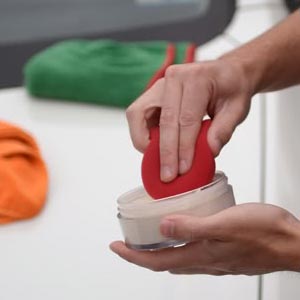You have no items in your shopping cart.
How to Apply Paste Wax
 While it was originally used as a protective barrier for wood, paste wax offers a beautiful shine and coating to virtually any wood product. Despite its original purpose, paste wax offers very little in terms of protection; the low melting point offers minimal protection against heat, often melting at 60 degrees and the water barrier is too low to offer any valuable protection against liquid.
While it was originally used as a protective barrier for wood, paste wax offers a beautiful shine and coating to virtually any wood product. Despite its original purpose, paste wax offers very little in terms of protection; the low melting point offers minimal protection against heat, often melting at 60 degrees and the water barrier is too low to offer any valuable protection against liquid.
Even without the protective properties, the finish paste wax offers is virtually unmatched by any other product, especially when it is used as a top coat to an already finished product (like polyurethane, lacquer or varnish). Likewise, paste wax can be used effectively to restore an old or dated piece of wood; especially those piece which are rarely handled or used.
Preparing the Piece for Paste Wax
If the product has never been waxed, it’s important to ensure that the item is clean and lint free. Start with a clean, damp cloth and wipe the entire surface vigorously to remove any visible dust or dirt from the entire surface. It’s important to pay close attention to any creases, cracks or crevices as they can be difficult to clean. Once the entire area has been wiped, allow the piece to completely dry.
Use a separate dry, clean, lint-free cloth to give the entire piece a wipe. If the piece is unfinished, consider using a finish like lacquer or varnish if you want to protect it against any scratches, heat, water or damages.
Preparing the Paste Wax
To properly apply the paste wax, you’ll need a clean, soft cotton cloth to apply it to the piece you’re finishing. Place a reasonably sized lump (approximately the size of a large coin for smaller pieces) to the centre of the rag. You’ll want to twist the cloth into a ball over the wax and manipulate the paste in your hand to soften the wax. Use a gently kneading motion to soften and warm the wax as you manipulate it—taking care to keep your hands around the entire cloth.
Applying the Paste Wax to the Piece
Apply the cloth on to the surface of your product, allowing the wax to transfer from the cloth to the wood. The paste wax will seep into the piece as the cloth lays on the surface. The method of applying the wax doesn’t typically affect the finished result, although many find that rubbing the wax with the grain initially with small gentle circles afterward leaves the best shine. When the surface sits for a short period of time (before it turns too hazy) wipe the excess wax off the piece with a clean cloth. What to Watch For When Applying Paste Wax When you initially apply the paste wax, there will be a significant gloss to the product. This gloss is the result of the solvent in the product and as the solvent evaporates, it will begin the process of becoming hazy. If this happens, simply rework another lump of wax and reapply. The solvent will soften the wax on the piece and you can remove the excess wax with a clean cloth.


